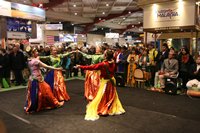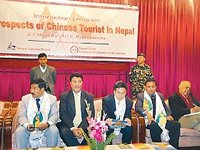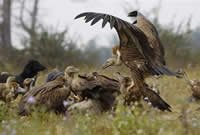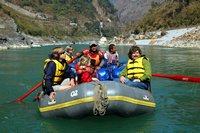| If you cannot view this Newsletter properly, Please click here. |
| |
|
| Weekly Official e-Newsletter of Nepal Tourism Board |
|
|
 |
|
|
Nepal participated Brussels Holidays Fair 2012
 Nepalese Embassy in Brussels in cooperation with Nepal Tourism Board participated Brussels Holidays Fair 2012 from February 2 to 6, 2012. More than 750 companies representing different embassies, tourism board, tour operators took part in this fair. Nepal's stall was designed on the theme of Visit Lumbini Year 2012. Staff of embassy distributed the promotional materials provided by Nepal Tourism Board and informed the visitors about Nepal and its tourism products. Mr. Roger de Groen, Honorary Consul of Nepal briefed the visitors about Nepal. On February 4 & 5, Nepalese Embassy, Non Resident Nepali Association and Euro Nepal Artists Association organised cultural program in the fair representing mountain, hills and terai. On February 6, a reception was organised for tour operators who sell Nepal in presence of Pramesh Kumar Hamal, Ambassador of Nepal to Belgium. Nepalese Embassy in Brussels in cooperation with Nepal Tourism Board participated Brussels Holidays Fair 2012 from February 2 to 6, 2012. More than 750 companies representing different embassies, tourism board, tour operators took part in this fair. Nepal's stall was designed on the theme of Visit Lumbini Year 2012. Staff of embassy distributed the promotional materials provided by Nepal Tourism Board and informed the visitors about Nepal and its tourism products. Mr. Roger de Groen, Honorary Consul of Nepal briefed the visitors about Nepal. On February 4 & 5, Nepalese Embassy, Non Resident Nepali Association and Euro Nepal Artists Association organised cultural program in the fair representing mountain, hills and terai. On February 6, a reception was organised for tour operators who sell Nepal in presence of Pramesh Kumar Hamal, Ambassador of Nepal to Belgium.

Tourism Promotion in Frankfurt
The Consul General of Frankfurt Mr. Bodo Krueger organized a New Year Reception as a chairman of the German–Asian Business Circle /Diplomatic Council on January 30, 2012 at the Congress Centre/Messe in Frankfurt. About 1000 guests and dignitaries were invited, including ambassadors from Asia pacific regions from Berlin and Consul General and Consuls from Frankfurt. The event was inaugurated by Interior Minister of Hessen Boris Rhein. There were 44 stalls from different vehicles manufacturing companies such as BMW and VW ,airlines companies such as Lufthansa and Air China.GIZ and KfW also had also represented there. Different Embassies and Consulates had also opened their stalls and Honorary Nepalese Consulate also for the first time had opened its stall with joint cooperation and support from the Embassy.
Suresh Pradhan, Ambassador,Embassy of Nepal, Berlin welcomed the Hessen Interior Minister at the Stall and briefed about the tourism prospect of Nepal and investment opportunity in Nepal, particularly in tourism, hydropower and infrastructure. Minister was also served Nepalese orthodox tea at the stall by Thomas Holz of Tee Gschewender.

All eyes on Chinese tourists
 Travel trade entrepreneurs and tourism stakeholders have urged the government to step up efforts to lure Chinese tourists as their numbers have been projected to grow much more than visitors from other countries. Travel trade entrepreneurs and tourism stakeholders have urged the government to step up efforts to lure Chinese tourists as their numbers have been projected to grow much more than visitors from other countries.
They said that the government, along with the private sector, should jointly understand the need of the Chinese—the world's fastest-growing Buddhist population and holiday seekers.
More flights, promotional materials in Chinese, more Chinese language guides, coordination between Nepali and Chinese travel agencies and understanding Chinese areas of interest in Nepal among other issues should be closely evaluated, they said at a programme entitled "Prospect of Chinese Tourist in Nepal" organized by the Nepal-China Chamber of Commerce and Industry (NCCCI) here on Thursday.
"China now has become the world's fourth largest outbound tourist market with high spending. Even if only a small portion could be attracted, it would be a great achievement for countries like Nepal," said Rajesh Kazi Shrestha, president of the NCCCI.
A boom in Chinese arrivals since the last two years has kept Nepal's tourism sector busy even during the off season. Chinese tourists have taken a great leap forward to reach 75,631 arrivals last year, a 63 percent growth year on year. There were 46,360 visitors from the northern neighbour in 2010.
Tourism entrepreneurs said that Chinese vacationers are showing a shift towards soft adventure activities, which Nepal has in abundance. The beginning of 2012 also saw a 107 percent rise in Chinese visitors. "We should realize that as Nepal is the birthplace of Buddha and has cultural similarities with China, it is easier for us to attract Chinese visitors," Shrestha said.
Realizing the potential of Chinese outbound, Minister for Tourism and Civil Aviation Lokendra Bista Magar urged the Chinese government to support the Visit Lumbini Year 2012 campaign in Nepal.
"The recent visit of Chinese Prime Minister Wen Jiabao has added more mileage to the existing ties between Nepal and China," Magar said, adding that the Chinese premier was positive about supporting development of Lumbini, the birthplace of Gautam Buddha.
Chinese Ambassador to Nepal Yang Houlan said that the visit of Premier Wen has also drawn attention of potential Chinese travellers to visit to Nepal. "Nepal has immense potential for tourism," Yang said. The tourism infrastructure needs to be develop to woo more visitors in the future, he added. He said that the spending of Chinese tourists in Nepal was relatively better than the expenditure made by visitors from other countries. Improving Tribhuvan International Airport or finding an alternative to the airport in Pokhara or other places and improving flight connectivity could attract more Chinese to Nepal. Chinese carriers China Southern, China Eastern and Air China operate on the Guangzhou-Kathmandu, Kunming-Kathmandu and Lhasa-Kathmandu sectors respectively.
Aditya Baral, spokesperson of the Nepal Tourism Board, said there had been persistent growth in Chinese arrivals since June 2009. Despite having immense prospects of attracting Chinese tourists, the country has been unable to reap the benefits fully. "There is a need for collaboration between the private and public sectors to boost tourism in Nepal."
Tourism entrepreneur Bikrum Pandey, presenting Chinese prospects in Nepal, underlined some weaknesses like negative publicity of Nepal hampering growth of Nepal's tourism.
(News courtesy: The Kathmandu Post)

Nepal's vulture "restaurants" for endangered birds
 In the village of Pithauli, surrounded by ripening mustard fields, a woman hauls a cow carcass on a trolley, drops it in an open field, then runs and hides in a nearby hut as dozens of vultures swoop down. In the village of Pithauli, surrounded by ripening mustard fields, a woman hauls a cow carcass on a trolley, drops it in an open field, then runs and hides in a nearby hut as dozens of vultures swoop down.
In under half an hour, the carcass has been reduced to picked bones by the dun-coloured birds, occasionally squabbling as they feed.
The site is one of a handful of vulture "restaurants" opened to save the birds, which help keep the environment clean by disposing of carrion, from extinction -- and at the same time help impoverished villages become self-sufficient.
A drug called diclofenac, used for treating inflammation in cattle, causes kidney failure and death in vultures which feed on their carcasses. As a result, two species of vulture -- the White-rumped and Slender-billed -- are now critically endangered in Nepal, as well as in Pakistan and India.
"If the situation continues the two species will be extinct in ten years," said Hem Sagar Baral, chief of the Nepalese Ornithological Union.
"We may maintain certain minimum numbers but we'll never see the numbers we had 20 years ago."
Two decades ago there were about 50,000 nesting pairs of the two vulture species in Nepal. Now, barely 500 pairs remain.
Their steep decline is blamed on the widespread use of diclofenac, which was banned in 2006, and loss of habitat, with the kapok trees they use for nesting vanishing fast to meet demand from factories producing match sticks and plywood.
Five years ago, Bird Conservation Nepal came up with the idea of "restaurants" as places where the birds could feed on safe carcasses.
Pithauli, some 100 km (60 miles) southwest of the Nepali capital of Kathmandu, was the site of the first such feeding station, which now number six around the country.
The number of nesting pairs there has grown to 46 compared with just 17 before the feeding site was opened five years ago, said Dhan Bahadur Chaudhary, who coordinates the project.
"When we started I had no idea how it would do. I am happy that we have come to this point," he said.
Baral agreed that the "eateries" and the ban on the drug had helped, with numbers stabilising after an initial rise, but noted that they still remain under threat.
For one thing, the ban on diclofenac use is being flouted by giving cattle a version of the drug intended for humans, meaning it is still taking its toll on the birds.
In addition, despite the vulture's positive depiction in Hindu mythology as fighting to free Sita, wife of the god-king Rama, from the clutches of a demon, the birds are widely reviled as ugly and the harbingers of bad luck.
Superstition And Success
Residents in Pithauli, a village of more than 6,000 people, tell how villagers carried out special "purification" rites when vultures perched on the roofs of their homes.
When an old villager died a few days after a vulture had alighted on his house, it was widely believed to have resulted from his failure to perform the proper ritual.
But in an effort to win over the villagers, the organisation that started the feeding stations provides training in income-generating activities such as beekeeping, trail and bridge construction, and tourist guide services.
They also give support to schools and public health offices.
"Initially, it was not easy. But the villagers started to support us gradually as we launched community activities for the local people," Chaudhary said.
Authorities have also set up a vulture breeding centre in the Chitwan National Park in the neighbouring jungle resort of Kasara, where 60 birds, captured in the wild, are being raised. Ultimately, they plan to release chicks into the wild.
The vulture restaurant has become a tourist attraction in the poverty-stricken village, and admission fees from visitors -- who last year numbered some 2,000 -- help support it.
Additional help comes from authorities who buy old and sick cattle from the villagers for $3 a head, a modest income. These animals are kept on a farm in a community-run forest and offered to the birds when they die naturally since killing a cow is illegal in deeply Hindu Nepal.
Despite the gains, though, some villagers remain sceptical.
"Why save a bird that feeds on dead animals?" said 34-year-old Chet Nath Gandell, noting that the birds sometimes leave parts of the carcasses unfinished.
"Stinking carrion pollutes the air and we are forced to breathe in a slow poison."
(News courtesy: Reuters)

|
|
 |
| Mr. Suresh Pradhan, Ambassador of Nepal to Germany(Middle) with Hessen Interior Minister Boris Rhein and Bodo Krueger, Ho. Consul General at Nepalese Stall in Frankfurt |
|
|
| |
Upcoming Events |
| |
| Just in case of Need, |
Nepal Police
Toll Free: 16600141516
Mobile No: 9849091139
Emergency: 100
Tourist Police 977-1-4247041
Tourism Crisis Cell 977-1-4442555/ 977-9751044088
|
|
| |
Photo Feature |
| Beauty of Nepal |
|
|
|
|

| Editor: Sarad Pradhan |
| Asst. Editor: Sudhan Subedi |
|
|
|
|
| |
|
| Nepal Tourism Board (NTB) has sought to ensure that the contents of this newsletter are accurate at the time of transmission. NTB does not accept responsibility for any damage, loss, injury or inconvenience arising in connection with the contents of this newsletter.
Nepal Tourism Board wishes to thank all stakeholders for their wonderful support and assistance for promoting Nepal as a happening destination. We request all tourism industry stakeholders to send us news and articles at mediacenter@ntb.org.np , ssubedi@ntb.org.np or ntbmediacenter@gmail.com to include them in the weekly E-newsletters. |
| |
|

 Nepalese Embassy in Brussels in cooperation with Nepal Tourism Board participated Brussels Holidays Fair 2012 from February 2 to 6, 2012. More than 750 companies representing different embassies, tourism board, tour operators took part in this fair. Nepal's stall was designed on the theme of Visit Lumbini Year 2012. Staff of embassy distributed the promotional materials provided by Nepal Tourism Board and informed the visitors about Nepal and its tourism products. Mr. Roger de Groen, Honorary Consul of Nepal briefed the visitors about Nepal. On February 4 & 5, Nepalese Embassy, Non Resident Nepali Association and Euro Nepal Artists Association organised cultural program in the fair representing mountain, hills and terai. On February 6, a reception was organised for tour operators who sell Nepal in presence of Pramesh Kumar Hamal, Ambassador of Nepal to Belgium.
Nepalese Embassy in Brussels in cooperation with Nepal Tourism Board participated Brussels Holidays Fair 2012 from February 2 to 6, 2012. More than 750 companies representing different embassies, tourism board, tour operators took part in this fair. Nepal's stall was designed on the theme of Visit Lumbini Year 2012. Staff of embassy distributed the promotional materials provided by Nepal Tourism Board and informed the visitors about Nepal and its tourism products. Mr. Roger de Groen, Honorary Consul of Nepal briefed the visitors about Nepal. On February 4 & 5, Nepalese Embassy, Non Resident Nepali Association and Euro Nepal Artists Association organised cultural program in the fair representing mountain, hills and terai. On February 6, a reception was organised for tour operators who sell Nepal in presence of Pramesh Kumar Hamal, Ambassador of Nepal to Belgium. Travel trade entrepreneurs and tourism stakeholders have urged the government to step up efforts to lure Chinese tourists as their numbers have been projected to grow much more than visitors from other countries.
Travel trade entrepreneurs and tourism stakeholders have urged the government to step up efforts to lure Chinese tourists as their numbers have been projected to grow much more than visitors from other countries.  In the village of Pithauli, surrounded by ripening mustard fields, a woman hauls a cow carcass on a trolley, drops it in an open field, then runs and hides in a nearby hut as dozens of vultures swoop down.
In the village of Pithauli, surrounded by ripening mustard fields, a woman hauls a cow carcass on a trolley, drops it in an open field, then runs and hides in a nearby hut as dozens of vultures swoop down.












